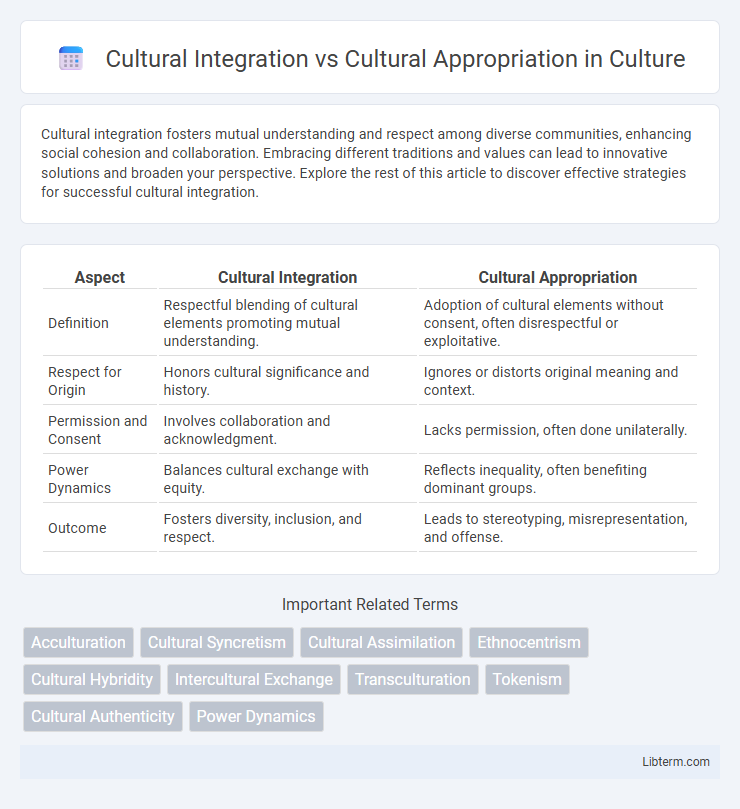Cultural integration fosters mutual understanding and respect among diverse communities, enhancing social cohesion and collaboration. Embracing different traditions and values can lead to innovative solutions and broaden your perspective. Explore the rest of this article to discover effective strategies for successful cultural integration.
Table of Comparison
| Aspect | Cultural Integration | Cultural Appropriation |
|---|---|---|
| Definition | Respectful blending of cultural elements promoting mutual understanding. | Adoption of cultural elements without consent, often disrespectful or exploitative. |
| Respect for Origin | Honors cultural significance and history. | Ignores or distorts original meaning and context. |
| Permission and Consent | Involves collaboration and acknowledgment. | Lacks permission, often done unilaterally. |
| Power Dynamics | Balances cultural exchange with equity. | Reflects inequality, often benefiting dominant groups. |
| Outcome | Fosters diversity, inclusion, and respect. | Leads to stereotyping, misrepresentation, and offense. |
Understanding Cultural Integration
Cultural integration involves the respectful blending of diverse cultural practices, values, and traditions within a community, promoting mutual understanding and social cohesion. It encourages appreciation and genuine exchange without erasing individual cultural identities or exploiting cultural symbols. This process fosters inclusivity, reducing social barriers and enabling multicultural societies to thrive harmoniously.
Defining Cultural Appropriation
Cultural appropriation involves the adoption of elements from one culture by members of another culture, often without understanding or respecting the original context and significance. It typically results in power imbalances where dominant groups exploit marginalized cultures, leading to stereotypes and commodification. Unlike cultural integration, which promotes mutual respect and exchange, cultural appropriation disregards cultural sensitivity and authenticity.
Historical Perspectives on Cultural Exchange
Historical perspectives on cultural exchange reveal that cultural integration fosters mutual respect and enrichment by blending traditions through shared experiences and cooperation among societies. In contrast, cultural appropriation often involves dominant groups adopting elements from marginalized cultures without acknowledgment, leading to distortion and exploitation. These dynamics reflect broader power imbalances and shape ongoing debates about identity, heritage, and ethical cultural interactions.
Key Differences Between Integration and Appropriation
Cultural integration involves respectfully adopting and blending elements from different cultures while preserving their original context and significance, fostering mutual understanding and enrichment. In contrast, cultural appropriation occurs when elements of a culture are taken out of context, often without permission, and used in a way that disrespects or devalues the source culture. The key differences lie in intent, respect, and awareness: integration emphasizes cultural appreciation and inclusivity, whereas appropriation often perpetuates stereotypes and power imbalances.
Benefits of Cultural Integration in Society
Cultural integration fosters mutual respect and understanding among diverse communities, enhancing social cohesion and reducing conflicts. It promotes the exchange of ideas, traditions, and values, leading to innovation and enriched societal experiences. Embracing cultural integration supports economic growth by encouraging inclusive workplaces and broadening markets through diverse perspectives.
Ethical Concerns of Cultural Appropriation
Cultural appropriation raises significant ethical concerns as it often involves the exploitation and misrepresentation of marginalized cultures by dominant groups, leading to the erasure of original cultural meanings and identities. This practice can perpetuate stereotypes, inequalities, and disrespect, undermining efforts toward genuine cultural understanding and respect. Ethical engagement requires recognizing power imbalances, seeking permission, and honoring the cultural significance behind symbols, traditions, and practices.
Real-World Examples of Cultural Integration
Cultural integration occurs when different cultural groups adopt and celebrate each other's customs in a respectful and meaningful way, as seen in the fusion of Latin and American music genres like Reggaeton. In contrast, cultural appropriation involves taking elements of a culture without permission or understanding, often stripping them of their original meaning. Real-world examples of cultural integration include the widespread acceptance of yoga in Western countries, where practitioners honor its Indian spiritual roots while adapting its practice to local contexts.
Controversial Cases of Cultural Appropriation
Controversial cases of cultural appropriation often involve fashion designers incorporating Indigenous patterns without permission or acknowledgment, leading to debates about respect and exploitation. Celebrities wearing sacred cultural symbols as mere accessories spark public outrage and highlight the fine line between appreciation and disrespect. These incidents underscore the need for cultural sensitivity and informed dialogue to differentiate genuine cultural integration from harmful appropriation.
Guidelines for Respectful Cultural Engagement
Guidelines for respectful cultural engagement emphasize authentic understanding, consent, and context to differentiate cultural integration from cultural appropriation. Engaging with cultural practices requires honoring their origins, giving credit to the community, and avoiding exploitation or misrepresentation. Active listening and continuous education foster mutual respect and meaningful cultural exchange without perpetuating stereotypes or disrespect.
Fostering Mutual Respect in a Globalized World
Fostering mutual respect in a globalized world requires recognizing the nuanced difference between cultural integration and cultural appropriation. Cultural integration promotes genuine exchange and appreciation, encouraging individuals to learn and honor diverse traditions while maintaining authenticity and consent. Emphasizing open dialogue and education helps prevent appropriation, ensuring that cultural expressions are shared respectfully and contribute to social harmony.
Cultural Integration Infographic

 libterm.com
libterm.com